Service robotics emerges as the next technology frontier with advancing skills, surging demand
These days, visitors to the presidential office in Seoul are getting a taste of the future.
At Sarangchae, a museum affiliated with Cheong Wa Dae, a kiosk-shaped robot greets guests with a heartwarming smile. Named Tiro, the machine introduces Korea’s culture and gives directions and answers in four different languages when visitors pick a question on its LED screen. Also on display are dancing robots, known as Metal Fighter, and the robotic dogs each called Genibo, which amuse both young and old and offer a glimpse into Korea’s advances in the industry.
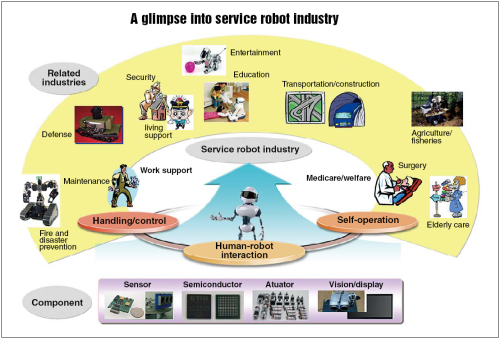
“Tiro is enjoying explosive popularity, especially among foreigners,” said Chin Hun-kook, chief marketing officer of Hanool Robotics Corp, which co-developed the project with four university research institutes. “Chinese, Japanese and other foreign tourists scramble to take pictures of themselves with it.”
For Hanool engineers, Tiro is much more than mindless metal. A couple of years ago, the humanoid was the emcee at a company engineer’s wedding. “It was a fun, very special ceremony,” Chin said. “We input speeches into Tiro with a timeline beforehand and everything went smoothly.”
These days, visitors to the presidential office in Seoul are getting a taste of the future.
At Sarangchae, a museum affiliated with Cheong Wa Dae, a kiosk-shaped robot greets guests with a heartwarming smile. Named Tiro, the machine introduces Korea’s culture and gives directions and answers in four different languages when visitors pick a question on its LED screen. Also on display are dancing robots, known as Metal Fighter, and the robotic dogs each called Genibo, which amuse both young and old and offer a glimpse into Korea’s advances in the industry.

“Tiro is enjoying explosive popularity, especially among foreigners,” said Chin Hun-kook, chief marketing officer of Hanool Robotics Corp, which co-developed the project with four university research institutes. “Chinese, Japanese and other foreign tourists scramble to take pictures of themselves with it.”
For Hanool engineers, Tiro is much more than mindless metal. A couple of years ago, the humanoid was the emcee at a company engineer’s wedding. “It was a fun, very special ceremony,” Chin said. “We input speeches into Tiro with a timeline beforehand and everything went smoothly.”
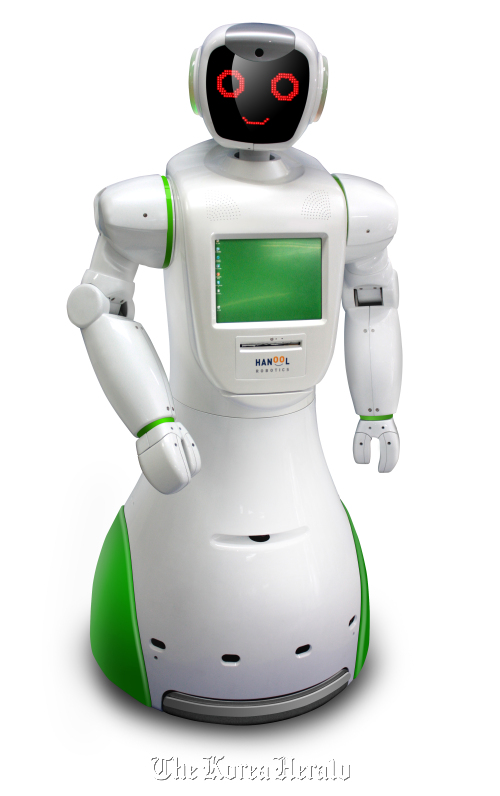
Tiro and its peers were installed in September 2010 in the presidential museum, visited by a monthly average of 70,000. They help attract more visitors, save costs on manpower, and more importantly are an advertisement of the nation’s cutting-edge technologies that made it a global leader in chips, mobile phones, TVs, display panels, and robotics that combine them all.
Korea is the world’s fourth-largest robot producer behind Japan, Germany and the U.S., controlling about 10 percent of global sales in 2009. Since 2003, the government has been boosting investment and supporting research and development in the nascent industry as one of the 10 next-generation growth engines.
Korea is now more ambitious as the mainstay of the industry is shifting from industrial machines to service robots such as home and office helpmates, robot teachers, surgery arms and other applications in which Korea has a strong potential with its electronics and telecommunications competitiveness.
Last month, the Ministry of Knowledge Economy announced a comprehensive package to promote the fledgling service robotics industry. It will spend 30 billion won ($26.7 million) for their development, commercialization, standardization and marketing over the next seven years.
In June, 11 consortiums of robot manufacturers and research institutions were selected to conduct six-month pilot programs into which the government has injected more than 2.1 billion won. Consortium leaders included Samsung Techwin, Nautilus Hyosung and Future Robot, the Korea Institute of Science and Technology and Kwangwoon University.
Growing market
Service robots typically assist humans with dirty, dangerous and repetitive tasks. They are used for household and office chores as well as professional tasks as surgery, navigation, milking, education, rescue, demining and military patrol operations.
With the workforce aging and labor costs rising, global sales of service robots are estimated to jump more than 26-fold to $85.5 billion in 2018 from $3.2 billion in 2008, according to the knowledge economy ministry data. The global robot market could reach $190 billion in 2020.
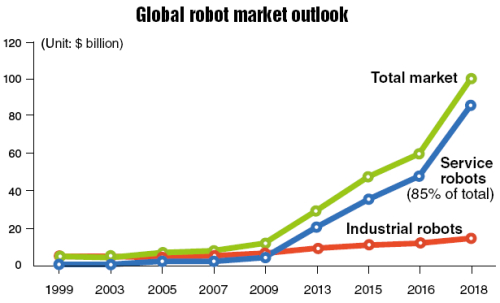
Around 8.7 million service robots were sold globally in 2009, up from some 7 million year-on-year, according to the Frankfurt-based International Federation of Robotics.
Of the total, household robots account for nearly 64 percent and entertainment and teaching robots 35 percent.
The Korean market is estimated at 1.02 trillion won in 2009, up more than 23 percent from 2008, according to the state-run Korea Institute for Robot Industry Advancement. Service robots and component manufacturing sectors are expanding by 40 percent each year, it said in a report.
Despite huge costs and technological limitations, the robotics industry is growing exponentially in line with the emergence of smarter, more human-like inventions with more diverse, specialized applications, the Samsung Economic Research Institute said.
“Service robots will leverage the entire industry’s growth,” the leading think tank said in a recent report. “Opportunities are still open for Korean companies to lead the market.”
One of the leaders in Korea is Nautilus Hyosung, which has gained a reputation for its brainchild, Fantasia Robot, which served as a guide in the lobby of the city hall of Bucheon, Gyeonggi Province until last year.
The 120-centimeter-tall robot allowed visitors to print parking permits and arrange meetings with city officials with a touch on its LED screen.
Fitted with a number of ultrasonic sensors and a laser scanner that detects obstacles, it escorted people to places inside the building.
The kiosk-shaped creation moves up to 50 centimeters per second and runs for eight hours once charged, said Kwon Yong-kwan, the firm’s robot development team chief.
“Fantasia Robot is a mixture of robotics technology and Hyosung’s expertise in financial services solutions,” he said. “It won huge popularity and interest from numerous visitors throughout the period.”
Robot cleaners
Vacuum-cleaning is the most popular sector with companies rolling out cheaper and more dexterous products. The global cleaning robot market, worth $506 million in 2009, is anticipated to reach $2 billion by 2016, according to market researcher Winter Green Research.
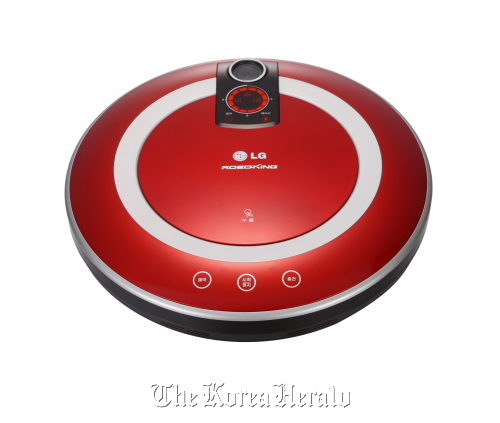
The Korean market is dominated by LG Electronics, whose RoboKing takes up about 52 percent share since March, according to the company.
RoboKing Dual Eye, the fifth-generation model that came out in late 2009, runs on lithium polymer batteries and carries two cameras and numerous sensors to read surroundings, LG said.
The robot sweeps and vacuums 30 percent faster than the previous model, it added.
“The superior quality and our aggressive marketing strategies helped secure the top spot,” said Lee Ki-young, marketing chief at the home appliance and air conditioning division.
LG recently began exporting the RoboKing to France, Italy and Spain, a spokesperson said. It will further target other countries this year.
Samsung Electronics launched Tango in Nov. 2009, an upgrade of its cleaning robots Hauzen and Furot.
It also has a camera and better navigating system with 13 sensors that recognize items from 2 centimeters away, the producer said.
“The robot cleaner market has bright prospects given high annual growth rates,” said Park Jong-hwan, managing director of Samsung’s consumer electronics division.
Hanool is also active in the market. Its intelligent cleaning robot Ottoro was introduced in 2003. On top of fast and powerful cleaning capabilities, the newest version boasts germ-killing functions and multiple sensors to avoid obstacles, the developer said.
The company landed a deal with German home appliance trader Hans Rumsauer GmbH in March to export 20 billion won worth of units of Ottoro.
The automated cleaner is now available in seven European nations including France, Belgium and the Czech Republic, Chin said.
As the market matures and competition becomes fiercer, prices are going down.
In terms of cleaning robots, when Swedish electronics manufacturer Electrolux introduced its Trilobite here in 2001, few consumers could afford the $2,000 price tag.
Current prices of robotic vacuum cleaners hover between 400,000 won and 900,000 won in general.
Smaller brands offer more reasonable prices ― Kyungmin Mechatronics’ MamiRobot is priced at about 300,000 won and Digix Semicon’s Digi-Robo at less than 200,000 won.
Tiro’s prices range between 150 million and 200 million won depending on what function customers want.
Diverse applications
Robots are widely used for highly technical applications albeit in small numbers.
The Korean Army adopted Hanool’s military robot Hanuri M1 several years ago for patrol and fire-fighting purposes.
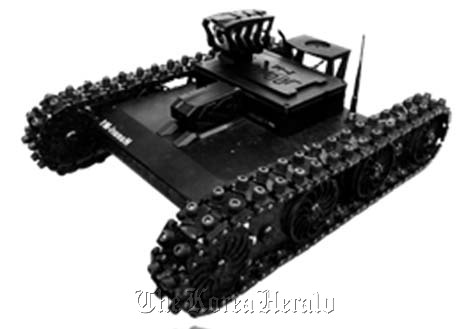
In April, the venture firm forged a $2.5 million deal to transfer technologies and jointly develop security and fire-fighting robots with the King Abdulaziz City for Science and Technology, Saudi Arabia’s national science agency and laboratories.
“The contract shows that a local start-up can pioneer an overseas market using accumulated technologies,” a company official said.
Samsung Techwin, specialized in digital cameras and optical equipments, won a $50 million order in May to test a robotic traffic control system in Algeria.
The pilot project aims to install 1,700 “intelligent surveillance cameras” in the capital city of Algiers to monitor and trace cars.
If the North African country agrees after the test, the Samsung affiliate will extend the system nationwide. The total export is valued at 1 trillion won.
Samsung set up a similar monitoring model in an oil bunker owned by the state-run Korean National Oil Corp. in Seosan, South Chungcheong Province, as part of the Knowledge Economy Ministry’s pilot program.
The test-bed facility operates surveillance robots, which are also designed to sense fire or oil leaks and report to the central command center in real time.

“The surveillance system is a successful model that creates synergy by merging robotics with IT technology,” said Cho Suk, chief of the ministry’s growth engine department. “We will focus on excavating and supporting such business models.”
In Daegu, southeast of the country, English teacher robots are favorites among elementary schoolers.
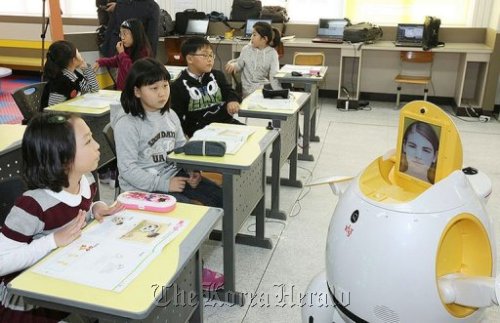
A total of 29 robots called Engkey started teaching youngsters at 21 schools last week in a three-month pilot project aimed at nurturing the promising industry, city officials said.
“We are expecting to build up a public consensus and uplift Daegu’s brand image as a robot leader through the pilot program,” a city official said. “If the project receives good responses from students, we’ll consider expanding the operation.”
Engkey stands one meter tall and has a LED panel that displays an avatar face of a teacher.
The white, egg-shaped device is remote-controlled by instructors from the Philippines. They can see and hear the children through the system, officials said.
Developed by the Korea Institute of Science of Technology, the robot speaks to students, reads books and dances while wheeling around the classroom.
Having robots in the classroom keeps children focused in class and gives them a greater amount of time speaking English, said Kim Mun-sang, director of the Center for Intelligent Robotics at KIST.
“It enables an equal quality of education whether they live in a city or rural area,” he said. “Plus, robots take about half of operating expenses compared with hiring foreigners.”
Developers plan to commercialize Engkey once the pilot program ends successfully, Kim added.
It currently costs 10 million won but he expects it to be reduced to 5 million won eventually.
Incheon said last year that it also planned to adopt robots as assistant teachers at kindergartens.
Other municipalities are venturing into other high-tech fields. North Gyeongsang Province, for instance, is heavily investing in a project to develop underwater robots. South Jeolla Province is building an automated management system for agricultural and fishery products. Gyeonggi Agricultural Research & Extension Services opened a robot-controlled plant factory last year.
By Shin Hyon-hee (heeshin@heraldcorp.com)





![[Herald Interview] 'Amid aging population, Korea to invite more young professionals from overseas'](http://res.heraldm.com/phpwas/restmb_idxmake.php?idx=644&simg=/content/image/2024/04/24/20240424050844_0.jpg&u=20240424200058)











![[KH Explains] Korean shipbuilding stocks rally: Real growth or bubble?](http://res.heraldm.com/phpwas/restmb_idxmake.php?idx=652&simg=/content/image/2024/04/25/20240425050656_0.jpg&u=)

